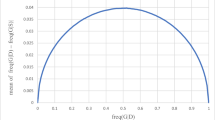Abstract
A common problem in anthropological field work is generalizing rules governing social interactions and relations (particularly kinship) from a series of examples. One class of machine learning algorithms is particularly well-suited to this task: inductive logic programming systems, as exemplified by FOIL. A knowledge base of relationships among individuals is established, in the form of a series of single-predicate facts. Given a set of positive and negative examples of a new relationship, the machine learning programs build a Horn clause description of the target relationship. The power of these algorithms to derive complex hypotheses is demonstrated for a set of kinship relationships drawn from the anthropological literature. FOIL extends the capabilities of earlier anthropology-specific learning programs by providing a more powerful representation for induced relationships, and is better able to learn in the face of noisy or incomplete data.
Similar content being viewed by others
Explore related subjects
Discover the latest articles, news and stories from top researchers in related subjects.References
Ascher, M. Ethnomathematics: A Multicultural View of Mathematical Ideas. Pacific Grove, CA, USA: Brooks/Cole Publishing Company, 1991.
De Meur, Gisele, Ed. New Trends in Mathematical Anthropology. London: Routledge & Kegan Paul, 1986.
Findler, N.V. and W.R. McKinzie. “On a Computer Program that Generates and Queries Kinship Structures.” Behavioral Science, 14 (1969), 334–343.
Findler, N.V. (1973). “Kinship Structures Revisited.” Behavioral Science, 18 (1969), 68–71.
Findler, N. V. “Automatic Rule Discovery for Field Work in Anthropology.” Computers and the Humanities, 26(4) (1992a), 285–292.
Findler, N.V. “An Excursion into Social and Cultural Anthropology by Artificial Intelligence — an Automated Discovery System to Identify Rules of Inheritance, Succession, Marriage, Injunction Against Incest, and Exogamy.” Computers in Human Behavior, 8 (1992b), 367–377.
Gregory, C.A. “A Matrix Approach to the Calculus of Kinship Relations.” (In De Meur, 1986), pp. 139–166.
Hinton, G.E. “Learning Distributed Representations of Concepts.” Proceedings of the Eight Annual Conference of the Cognitive Science Society. Lawrence Erlbaum Press, 1986.
Holte, R.C. “Very Simple Classification Rules Perform Well on Most Commonly Used Datasets.” Machine Learning, 11 (1993), 63–91.
Quinlan, J.R. “Learning Logical Definitions from Relations.” Machine Learning, 5 (1990), 239–266.
Author information
Authors and Affiliations
Rights and permissions
About this article
Cite this article
Cunningham, S.J. Machine learning applications in anthropology: Automated discovery over kinship structures. Comput Hum 30, 401–406 (1996). https://doi.org/10.1007/BF00057936
Issue Date:
DOI: https://doi.org/10.1007/BF00057936




